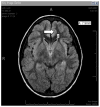Reproducibility of detecting silent cerebral infarcts in pediatric sickle cell anemia
- PMID: 24309240
- PMCID: PMC4096057
- DOI: 10.1177/0883073813506491
Reproducibility of detecting silent cerebral infarcts in pediatric sickle cell anemia
Abstract
Detecting silent cerebral infarcts on magnetic resonance images (MRIs) in children with sickle cell anemia is challenging, yet reproducibility of readings has not been examined in this population. We evaluated consensus rating, inter-, and intra-grader agreement associated with detecting silent cerebral infarct on screening MRI in the Silent Infarct Transfusion Trial. Three neuroradiologists provided consensus decisions for 1073 MRIs. A random sample of 53 scans was reanalyzed in blinded fashion. Agreement between first and second consensus ratings was substantial (κ = 0.70, P < .0001), as was overall intergrader agreement (κ = 0.76, P < .0001). In the test-retest sample, intragrader agreement ranged from κ of 0.57 to 0.76. Consensus decisions were more concordant when MRIs contained more than one larger lesions. Routine use of MRI to screen for silent cerebral infarcts in the research setting is reproducible in sickle cell anemia and agreement among neuroradiologists is sufficient.
Keywords: reliability testing; sickle cell disease; stroke.
© The Author(s) 2013.
Conflict of interest statement
Declaration of Conflicting Interests
The authors have no conflicting interests to disclose.
Figures


References
-
- Ohene-Frempong K, Weiner SJ, Sleeper LA, et al. Cerebrovascular accidents in sickle cell disease: rates and risk factors. Blood. 1998;91(1):288–294. - PubMed
-
- Pegelow CH, Macklin EA, Moser FG, et al. Longitudinal changes in brain magnetic resonance imaging findings in children with sickle cell disease. Blood. 2002;99(8):3014–3018. - PubMed
-
- Miller ST, Macklin EA, Pegelow CH, et al. Silent infarction as a risk factor for overt stroke in children with sickle cell anemia: a report from the Cooperative Study of Sickle Cell Disease. J Pediatr. 2001;139(3):385–390. - PubMed
Publication types
MeSH terms
Grants and funding
LinkOut - more resources
Full Text Sources
Other Literature Sources
Medical

